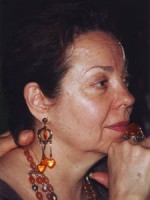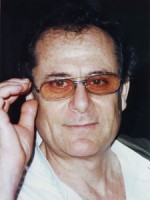Title
As a young artist, Moni Yakim moved from his native Israel (after completing his military service) to the creative whirlwind of Paris in the early ’60s. There he discovered both his love of the art of mime, and the love of his life, Mina Yakin. This month, Moni and Mina each will direct a show with Juilliard’s third-year class of actors (Group 38), as Fables of La Fontaine and Dylan Thomas’s Under Milk Wood are staged in the Drama Division’s Studio 301.
Body
The husband-and-wife team, who were introduced by the late Marcel Marceau, are both members of the faculty. In fact, Moni Yakim is the only remaining member of the original faculty of the Drama Division, assembled by John Houseman and Michel Saint-Denis in 1967, still teaching at the School today. Moni heads movement training for the division, teaching the second- through fourth-year movement classes. Mina, meanwhile, teaches mask work to first- and second-year students, and has been a member of the faculty since 1997.
Over the years, many new drama students have puzzled over the slight difference in their last names. The discrepancy stems from when the two were just starting to perform their mime act in the United States. They arrived at the theater one evening, ready to perform, but there was one small snag: the posters for their upcoming performance had the wrong name on them. Rather than heralding the arrival of the Yakins, the posters announced the Yakims would perform. It seemed easier to change their name rather than the posters, so they performed from then on as the Yakims. Moni still goes by Yakim, since that is the name by which he is known, while Mina and their two sons, Erez (a graphic novel illustrator) and Boaz (a filmmaker), go by the original last name of Yakin.
What draws the two projects being done this December together (other than the relationship of the directors) is that both Under Milk Wood and Fables of La Fontaine are essentially works of poetry first and drama second; both have been passed down from a different time and culture; and both present many complicated challenges to the actors and the directors.
Moni is directing Under Milk Wood, a work written as a radio play and originally intended to be conveyed through the voices of the actors alone—presenting special challenges for those who engage in translating the rhythms of this piece to the stage physically, as well as vocally. It is written in the surprisingly difficult Welsh dialect, and the intricately textured poetry of the play makes it, according to Moni, “a very difficult poem to decode—it is not easy at all, [because] it has a lot of linguistic twists and turns that one has to discover.” These challenges, however, are exactly why Moni chose this play. The impulse to stage it stemmed from a series of improvisations that the Group 38 actors did in their second-year class with Moni, in which they would pretend they were in different countries. For these improvisations, however, Moni recalls that they would all choose “to do American tourists in these countries, rather than get into the dialects and the type of behavior of other countries. And that’s, I think, what just planted the thought in my head, that [Group 38] should do something that would sound almost foreign, that would have a dialect that is not easy to do. I thought that it would be very beneficial for the class.”
The play centers around the fictional Welsh village of Llareggyb (originally Llareggub, which is “bugger all” spelled backwards, but some published editions changed the spelling so as not to offend), a seaside town filled with many eccentric characters revealed to the audience through their dreams and desires—from Captain Cat, who wistfully dreams about his lost brethren of the seas, to Nogood Boyo, who dreams of nothing. All this is tied together by narrating voices revealing the inner depths of each character. “It is a superb, beautiful, different poem,” says Moni, for whom poetry is a deep passion (he is, in fact, a published poet in his native Hebrew). The aim of the cast is to take the bold verbal imagery of Thomas and the vibrant physical imagery of Yakim and blend them into a beautiful work of art—and they are up to the challenge.
Mina Yakin will direct Fables of La Fontaine—actually not a play at all, but a group of selected fables by the French poet Jean de La Fontaine (1621-95) that have been translated into English as closely and artistically as possible. In an effort toward complete collaboration, the script for this performance is being developed during rehearsals with input from all of the actors. The fables, originally inspired by those of Aesop, center on the lives and interactions of animals inhabiting a fictional forest. But the stories are “not only about the animals,” explains Mina, “but about human relations to the animals, and human relations to nature itself … and how we also abuse them.” Often La Fontaine chose certain animals to represent certain types in 17th-century French society (the lion is a king, the fox a dashing but deceptive trickster, the hare a nervous wreck), allowing him to write sometimes scathing social and political commentary and avoid accusations of slander. The real draw of these fables—and the reason they are still taught in French-speaking schools to this day—is that they are works of beautiful poetry, universal in a way that allows modern readers to see themselves in the animals being portrayed.
In order to truly enter into the world of the fables, the actors will be performing in animal masks. “I think what you achieve with masks,” says Mina, “especially animal masks, is a complete and total physical expression, vocal expression, use of your imagination, [freeing you to] do things that you would never do as a human being because you would be inhibited.” Mina, who is writing a book on the subject of mask work for actors, has helped guide the third-years to a physically uninhibited state many times before, as animal mask work is an important component of the second year of training. Her excitement for this project is intensified by her longstanding love of the material; she has wanted to direct a mask show based on the Fables of La Fontaine—which she describes as “absolutely spirited and beautiful”—ever since she fell in love with them during her years in Paris.
Moni and Mina have a busy period ahead with the shows to be performed. But they are in it together. And it will be a treat for both audiences and actors to see this extraordinary couple direct side by side, expressing their love for art, and their love for each other, through beautiful poetry that speaks right to their souls.






